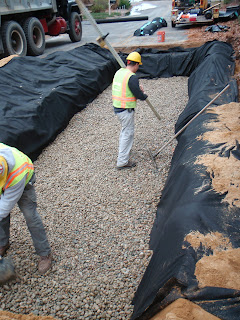By Lindsay Cook, CCCD Intern and Abigail Franklin, CCCD Fish Passage Project Manager
The Cape Cod Conservation District is constantly on the lookout for areas where the staff’s hard work would help to protect or restore habitats for Cape Cod’s diverse wildlife and fish species. One of the areas that will soon benefit from the Cape Cod Water Resources Restoration Project is in the Marstons Mills section of Barnstable, Massachusetts.
In April, a crew from the CCCD, USDA Natural Resources Conservation Service and the Town of Barnstable went to the site of a 1,200 foot long wooden flume and fish ladder along the Martsons Mills River that provides river herring a way to swim around some cranberry bogs on their way to the spawning grounds in Middle Pond.
The existing structure, first built in the 1880’s and rebuilt in the 1940’s and 1990’s, has always required constant maintenance by local volunteers and town employees. Today, many sections are rotting, causing water to leak out the sides. The weirs – or ladder steps – are prone to clogging by debris, and the difference in water levels in the concrete water control structure tends to delay the migrating fish.
To correct these problems, the fish ladder and flume will be replaced with a watertight concrete structure that will allow for more efficient use of water from the pond. A path along the structure will help volunteers remove sticks and leaves from the weirs, and two new steps will be added in the water control structure to help fish swim through.
The design for the project is 85 percent complete and several meetings have been held with the project partners, including the residents who live along the ladder. The projected life of this new ladder is much longer than the wooden structures of the past and will therefore not need to be rebuilt again and again.
During the April site visit, the crew surveyed the banks on either side of the flume to determine how to preserve as many trees as possible during the construction process. Maintaining tree cover is important to keep the water cool for the passing herring.
 |
| Alisha Parker, Property Management Coordinator with the Town of Barnstable Growth Management Department carries stakes to the next cross section that will be surveyed. |
Stakes were placed every 100 feet, the slope of the banks was surveyed, tree locations were recorded, and pictures were taken. Thanks to the help of the project partners, the work was accomplished in an afternoon.
At the end of the day, some herring swam by to take a look at the progress! Take a look:












